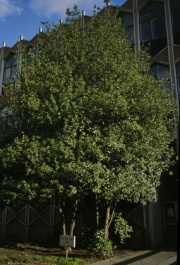Difference between revisions of "Laurel"
Jump to navigation
Jump to search
| Line 13: | Line 13: | ||
== Physical and Chemical Properties == | == Physical and Chemical Properties == | ||
| − | + | * Large evergreen tree growing to 35 m often with multiple stems. | |
| − | + | * Bark=thin reddish-brown and scaly | |
| − | + | * Leaves=elliptical (7-10 cm) and aromatic when crushed. | |
| − | + | * Fruit =spherical drupe (2 cm) attached with stem resembling a golfers tee. | |
| − | + | * Density = 50 ppcf | |
== Sources Checked for Data in Record == | == Sources Checked for Data in Record == | ||
Revision as of 09:03, 9 October 2020
Description
An aromatic evergreen tree, Laurus nobilis, native to the Mediterranean region. The laurel tree, or bay laurel, is grown commercially for the aromatic oil that is pressed from its berries. The wood from the laurel tree is strong and elastic. It is typically used for small novelties, carving and marquetry.
See also California laurel.
Synonyms and Related Terms
Laurus nobilis; laurier (Fr.); laurel (Esp.); loureiro vulgar (Port.); alloro (It.); bay laurel; sweet bay; wax myrtle
Physical and Chemical Properties
- Large evergreen tree growing to 35 m often with multiple stems.
- Bark=thin reddish-brown and scaly
- Leaves=elliptical (7-10 cm) and aromatic when crushed.
- Fruit =spherical drupe (2 cm) attached with stem resembling a golfers tee.
- Density = 50 ppcf
Sources Checked for Data in Record
- Ralph Mayer, A Dictionary of Art Terms and Techniques, Harper and Row Publishers, New York, 1969 (also 1945 printing)
- F. H. Titmuss, Commercial Timbers of the World, The Technical Press Ltd., London, 1965
- Wikipedia: http://en.wikipedia.org/wiki/Bay_laurel (Accessed Feb. 10, 2006)

